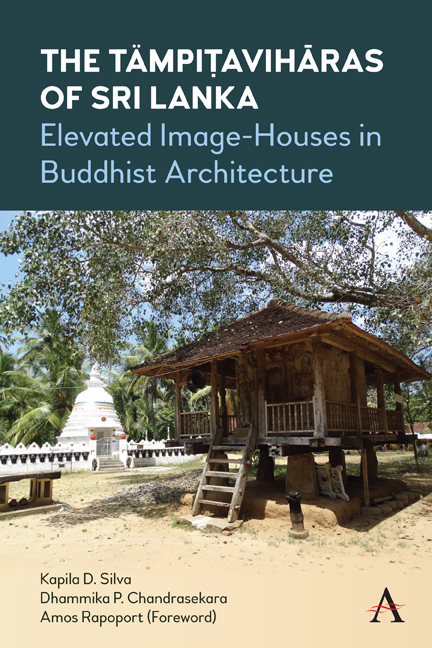Sabaragamuva Province
Published online by Cambridge University Press: 16 December 2021
Summary
Ambuḷugala Ṭӓmpiṭavihāra, Kǟgalle District
The ṭämpiṭavihāra was constructed for the safe keeping of the sacred tooth relic of the Buddha during the reign of Parākramabāhu VII (1478– 1484) of the Kōṭṭē period. The construction of this two-storey image-house was carried out under the guidance of Vǟkoladeṇiyē Nallaperumāl āchāri (master architect), presumably the architect of the royal court, thus indicating the direct patronage of the king. In the original design, the upper storey functioned as the relic chamber and the lower storey as an imagehouse. In the early 1800s, the ṭämpiṭavihāra was renovated under the patronage of Vattēgama Thērō (Abeywardana 2002). The lower-level chamber was removed and converted into an open pavilion, while the upper level was converted into an image-house. The elaborately carved stone door frame of the lower storey of the original structure has been left in place. The stone columns of the lower level and the wooden columns of the upper level are all richly carved. These represent the design motifs in use during the Kōṭṭē period. The material, width, and the number of columns in the ambulatories of the two floors differ: a higher number of slender wooden columns are placed on the upper floor, with thicker stone columns on the lower floor. This accentuates the elevated ‘floating’ expression of the upper floor with a heavier look for the lower floor. The ambulatories of the two floors are connected via a staircase placed in the rear of the structure. The Ambuḷugala Raja Mahā Vihāra is situated 13 km east of Kǟgalla and 3 km south on Ambuḷugala-Dehimaḍuva road from Utuvankanda junction on Colombo-Kandy road.
Kaḍigamuva Ṭӓmpiṭavihāra (Lower Terrace), Kǟgalle District
The Kaḍigamuva Nāgavanārāma Purāṇa Raja Mahā Vihāra is perhaps the only temple with two ṭämpiṭavihāras and one ṭämpiṭa-dēvāla. The temple is located 7.4 km from Rambukkana, on Rambukkana-Māvanälla road. Its recorded history dates to the reign of Gajabāhu I (112– 134 CE), and the temple has received royal patronage from all the rulers of the Kandyan period. Kaḍigamuvē Dhammajoti Thērō, the then chief incumbent of the temple, received higher ordination from Upāli of Siam at the re-establishment of higher ordination during the reign of Kīrti Śrī Rājasiṅghe (1747– 1780 CE) (Abeyawardana 2002).
- Type
- Chapter
- Information
- The Tämpitaviharas of Sri LankaElevated Image-Houses in Buddhist Architecture, pp. 127 - 150Publisher: Anthem PressPrint publication year: 2021



